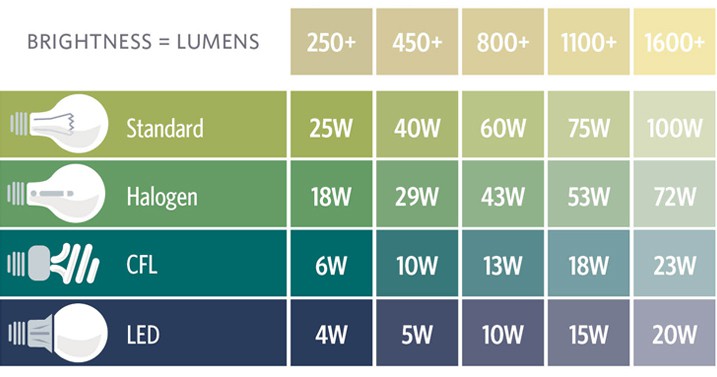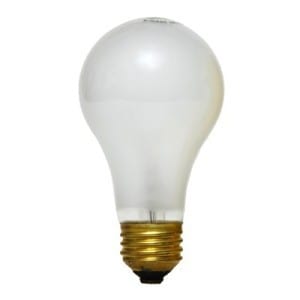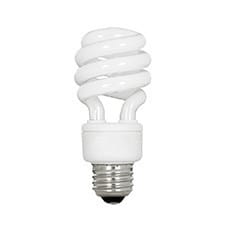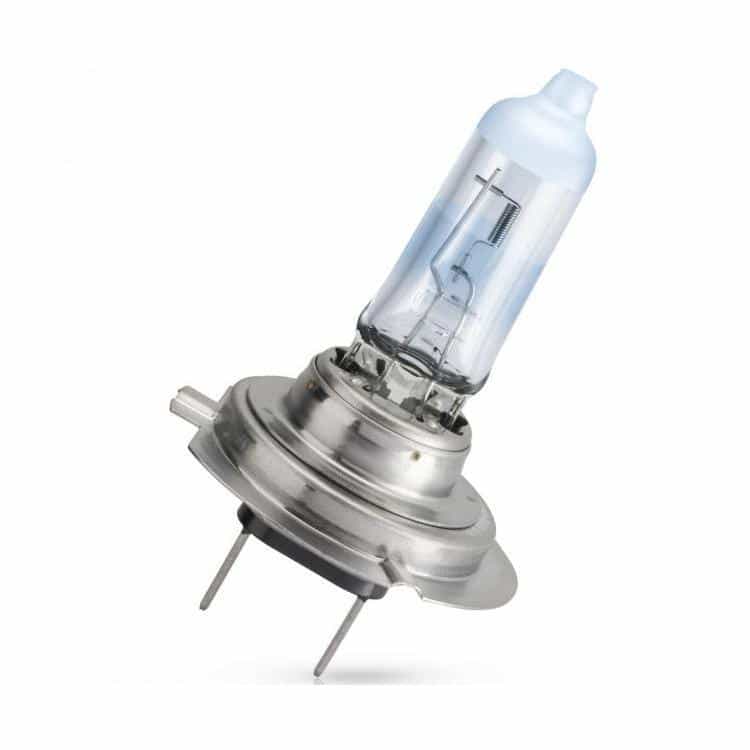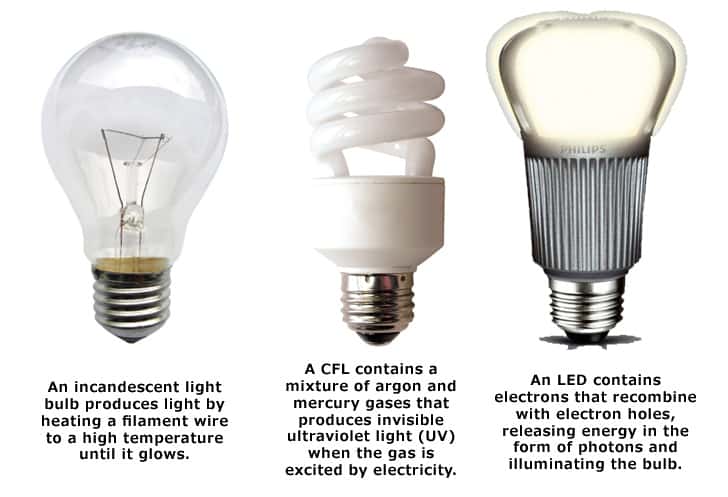
You know you want to “go green,” but there are SO many ways and so many choices – where do you start?
One good place to start is with your lighting! We all need lights and light bulbs in our homes – so why not start there!
Light bulbs on the market now are more environmentally friendly and can save you money. But, with all the different types of bulbs available, how do you know which bulbs are right for your situation? There are the incandescent, fluorescent, halogen, light-emitting diodes (LED), and compact fluorescent light bulbs (CFL)… So, what’s a person to do?
Let me “enlighten” you….
Before you start making decisions on what lighting is right for you, here is a quick lesson in lighting terminology:
- Wattage: The amount of electricity consumed by a light source
- Lumens: The amount of light that a light source produces
- Efficacy: Lumens per watt
- Footcandles: the amount of light reaching a subject
You know how when you go to change an incandescent light bulb and it is hot to the touch? In Green Goes with Everything: Simple Steps to a Healthier Life and a Cleaner Planet author Sloan Barnett explains that happens because an incandescent bulb is “…basically a little electric space heater that just happens to also give off light.” Do you know if you have a 60 watt incandescent bulb, the wattage refers to how much energy the bulb uses (60 watts) – not how much light is given off…
A CFL bulb produces a warm, soft, diffused light and can last up to 10,000 hours! They emit as much light as an incandescent bulb, but use one-fourth the energy.
A downside of CFL bulbs is that they take longer to reach full illumination. They are also more expensive than incandescent bulbs. However, they last so much longer they will more than pay for themselves over the long run. Another downside is that CFL bulbs contain a small amount of mercury which can be released if it breaks or is disposed of improperly. Even with the mercury each bulb contains, the EPA says CFL bulbs still help reduce mercury emissions in the United States because of significant energy savings. They reduce the demand for electricity, which reduces the amount of coal burned by power plants, which reduces emissions of mercury when the coal is burned.
There are specific cleanup instructions if a bulb containing mercury should happen to break. These include airing the room out, specific materials to clean up and dispose of the broken bulb. Visit the EPA website in order to find out the complete instructions for cleaning up a broken CFL bulb. It is important to recycle used CFLs, also. Recycling prevents the release of mercury into the environment. Most of the materials in fluorescent bulbs are recyclable and can be reused. Many states and local jurisdictions have regulations about disposal of CFL bulbs, so be sure to check your local regulations. Visit the EPA recycling webpage for more information.
Think a CFL bulb is too harsh, too white and way too bright? Many new CFL bulbs are designed to mimic the yellowy light of an incandescent bulb. There are now silicone covered CFL bulbs which give off a softer, more pleasant glow.
A Halogen bulb – or a “tungsten-halogen filament incandescent bulb” – contains a small capsule of halogen gas, which provides a bright white light. They produce more light, use less energy and last longer than the standard incandescent bulb. They do cost more, but last from 2-3 years. Halogen bulbs are often used in vehicle headlights.
 An LED uses semiconductor technology to emit narrow-spectrum diodes when an electrical current passes through it. In 2014, 19% of global electricity and 6% of greenhouse gas emissions were attributable to lighting. In the beginning, only red LEDs were available and used primarily as the indicator lights in electronic appliances and equipment. Green, yellow and blue LEDs are now available – most of the new holiday lights are the primary colored LED lights. White, super-bright, LEDs are now widely used in entertainment, retail, residential, safety and security lighting, and outdoor area lighting, not to mention backlit TVs and video screens.
An LED uses semiconductor technology to emit narrow-spectrum diodes when an electrical current passes through it. In 2014, 19% of global electricity and 6% of greenhouse gas emissions were attributable to lighting. In the beginning, only red LEDs were available and used primarily as the indicator lights in electronic appliances and equipment. Green, yellow and blue LEDs are now available – most of the new holiday lights are the primary colored LED lights. White, super-bright, LEDs are now widely used in entertainment, retail, residential, safety and security lighting, and outdoor area lighting, not to mention backlit TVs and video screens.
Want a little guidance when selecting your light bulbs? Energy Star has a guide on their webpage to help you choose just the right bulb. An Energy Star light bulb has:
- Been independently certified to deliver efficiency & performance
- Has the same brightness (lumens), 90% less energy (watts)
- Will last 15 times longer – which equals money savings
- They help protect the environment & prevent climate change
Want to try your hand at making your own LED lightbulb?
Resources:
Horn, Greg. 2006. Living green : a practical guide for simple sustainability. Topanga, CA : Free Press. Engineering Library RA776.5 .H65 2006
Ryan, Eric. 2008. Squeaky green : the Method guide to detoxing your home. San Francisco : Chronicle Books. Engineering Library RA770.5 .R993 2008
Barnett, Sloan. 2008. Green goes with everything : simple steps to a healthier life and a cleaner planet. New York : Atria Books. Engineering Library RA770 .B37 2008
Lo, Teddy. 2014. Planet LED. Novato, California : ORO Editions. Engineering Library TK7871 .89 .L53 L6 2014
Choose a Light Guide. Energy Star : The simple choice for energy efficiency. EPA and DOE. Date accessed: Dec. 6, 2016
Types of Light Sources and Light Bulbs. 2016. American Lighting Association.
Compact Fluorescent Light Bulbs (CFLs). Aug. 10, 2016. US Environmental Protection Agency.
Make Your Own LED Libghtbulb! May 22, 2015. youtube
Other Resources:
United States. Federal Trade Commission. Office of Consumer and Business Education, : United States. Department of Energy. 2006. Energy efficient light bulbs a bright idea. Washington, D.D. : Federal Trade Commission, Bureau of Consumer Protection, Office of Consumer and Business Education. Digital PDF [electronic resource].
Get to know your light bulbs with our comprehensive type guides. Bulbs.com : The LED Authority. Date accessed Feb. 6, 2017.
Christmas Lights Power Consumption. Feb. 6, 2017. Christmas Lights, Etc.

